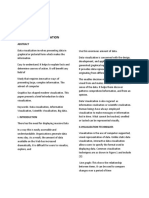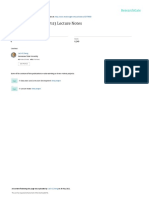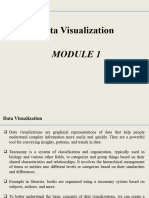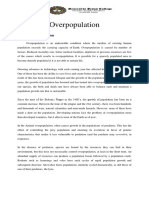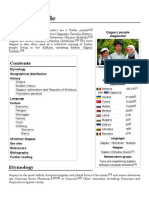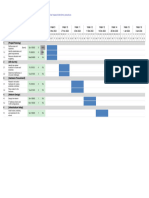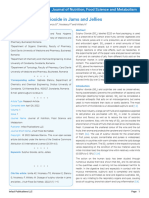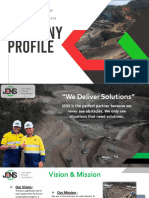Chapter 8: Data
Representation and
Visualization
Chapter Index
S. Reference Particulars Slide
No. No. From - To
1 Learning Objectives 4
2 Topic 1 Ways of Representing Visu 5-8
al Data
3 Topic 2 Techniques Used for Visual 9-10
Data Representation
4 Topic 3 Types of Data Visualization 11-12
5 Topic 4 Applications of Data Visuali 13-14
zation
Chapter Index
S. Reference Particulars Slide
No. No. From - To
6 Topic 5 Visualizing Big Data 15 - 17
7 Topic 6 Tools used in Data Visualiz 18 - 20
ation
8 Topic 7 Tableau Products 21
9 Topic 8 Data Visualization for Man 22
agers
10 Let’s Sum Up 23
Learning Objectives
Describe the meaning of visualization
Discuss the importance of Big Data visualization
Explain the tools used in data visualization
Describe the Tableau products
Discuss how data visualization is useful for managers
1. Ways of Representing Visual Data
Data visualization can be understood as a technique which
can be used to communicate data or information by
transforming it into pictorial or graphical format.
It represents the data as visual objects, with the help of
visual aids such as graphs, bar, histograms, tables, pie
charts, mind maps, etc.
The main purpose of data visualization is to make users
understand the information clearly and efficiently. It is one of
the important steps in data analysis or data science.
Infographics are the visual representations of information or
data rapidly and accurately.
1. Ways of Representing Visual Data
Visualisation is an excellent medium to analyse, comprehend,
and share information because of the following reasons:
Visual images help to transmit a huge amount of information
to the human brain at a glance.
Visual images help in establishing relationships and distinction
between different patterns or processes easily.
Visual interpretations help in exploring data from different
angles, which help gain insights.
Visualization helps in identifying problems and understanding
trends and outliers.
Visualizations point out key or interesting breakthroughs in a
large dataset.
1. Ways of Representing Visual Data
Data can be classified on the basis of the following three criteria
irrespective of whether it is presented as data visualization or
infographics:
Method of creation: It refers to the type of content used while
creating any graphical representation.
Quantity of data displayed: It refers to the amount of data
which is represented. For example, geographical map,
companies financial data, etc.
Degree of creativity applied: It refers to the extent to
which the data is created graphically or designed in a colorful
way or it is just showing some important data in black and white
diagrams.
1. Ways of Representing Visual Data
Following are some content types of Data Visualization::
Graph: A representation in which X and Y axes are used to
depict the meaning of the information
Diagram: A two-dimensional representation of information
to show how something works
Timeline: A representation of important events in a
sequence with the help of self-explanatory visual material
Flowchart: A representation of instructions which shows
how something works or a step-by step procedure to perform a
task
Mind Map: A type of diagram which is used to visually
2. Techniques Used for Visual Data
Representation
Some techniques used for a visual presentation of data are as follows:
Isoline: It is a 2D data representation of a curved line that moves
constantly on the surface of a graph.
Isosurface: It is a 3D representation of an isoline. Isosurfaces are
created to represent points that are bounded in a volume of space
by a constant value, that is, in a domain that covers 3D space.
Direct Volume Rendering (DVR): It is a method used for
obtaining a 2D projection for a 3D dataset.
Streamline: It is a field line that results from the velocity vector
field description of the data flow.
Map: It is a visual representation of locations within a specific
area. It is depicted on a planar surface.
2. Techniques Used for Visual Data
Representation
Parallel Coordinate Plot: It is a visualization technique of
representing multidimensional data.
Venn Diagram: It is used to represent logical relations between
finite collections of sets.
Timeline: It is used to represent a chronological display of
events.
Euler Diagram: It is a representation of the relationships
between sets.
Hyperbolic Trees: They represent graphs that are drawn using
the hyperbolic geometry.
Cluster Diagram: It represents a cluster, such as a cluster of
astronomic entities.
Ordinogram: It is used to analyze various sets of multivariate
3.Types of Data Visualization
The following table briefly describes the different types of data
visualisation:
Name Description Tools
1D/Linear A list of items organized in Generally, no tool is used
a predefined manner for 1D visualization
2D/Planar Choropleth, cartogram, dot GeoCommons, Google
distribution map, and Maps API, Polymaps,
proportional symbol map Tableau Public etc.
3D/ 3D computer models, AC3D, AutoQ3D,
Volumetric surface rendering, volume TrueSpace
rendering, and computer
simulations
Temporal Timeline, time series, Gantt TimeFlow, Timeline JS,
chart, sanky diagram, Excel, Timeplot, Tableau
alluvial diagram, and Public etc.
connected scatter plot
3.Types of Data Visualization
Name Description Tools
Multidimensiona Pie chart, histogram, Many Eyes, Google
l tag cloud, bubble Charts, Tableau Public,
cloud, bar chart, and Google Fusion
scatter plot, heat map, Tables
etc.
Tree/Hierarchical Dendogram, radial d3, Google Charts,
tree, hyperbolic and Network
tree, and wedge stack Workbench/Sci2
graph
Network Matrix, node link Pajek, Gephi, NodeXL,
diagram, hive plot, VOSviewer, UCINET,
and tube map GUESS, Network
Workbench/Sci2,
sigma.js, d3/Protovis,
Many Eyes, and
Google
Fusion Tables
4. Applications of Data Visualization
Some of the areas in which we apply data visualization are as
follows:
Education: Visualization is applied to teach a topic that
requires simulation or modeling of any object or process.
Organ system or structure of an atom is best described with
the help of diagrams or animations.
Information: Visualization is applied to transform
abstract data into visual forms for easy interpretation and
further exploration.
Production: Various applications are used to create 3D
models of products for better viewing and manipulation. Real
estate, communication, and automobile industry extensively
4. Applications of Data Visualization
Science: Every field of science including fluid dynamics,
astrophysics, and medicine use visual representation of
information.
Systems visualization: Systems visualization is a relatively
new concept that integrates visual techniques to better
describe complex systems.
Visual communication: Multimedia and entertainment
industry use visuals to communicate their ideas and
information.
Visual analytics: It refers to the science of analytical
reasoning supported by the interactive visual interface. The
data generated by social media interaction is interpreted
5.Visualizing Big Data
Visual analysis of data is not a new thing. For years, statisticians and
analysts have been using visualisation tools and techniques to
interpret and present the outcomes of their analyses.
Almost every organisation today is struggling to tackle the huge
amount of data pouring in every day. Data visualisation is a great way
to reduce the turn-around time consumed in interpreting Big Data.
Traditional visualisation techniques are not efficient enough to capture
or interpret the information that Big Data possesses. For example,
such techniques are not able to interpret videos, audios, and complex
sentences.
Big Data is highly dynamic in function and therefore, most traditional
tools are not able to generate quality results. The response time of
traditional tools is quite high, making it unfit for quality interaction.
5.Visualizing Big Data
Deriving Business solutions
Almost every company nowadays is working with Big Data
and facing the following challenges:
Most data is in unstructured form
Data is not analyzed in real time
The amount of data generated is huge
There is a lack of efficient tools and techniques
Tools such as Hadoop are providing the state-of-the-art
technology to store and process Big Data.
Analytical tools are now able to produce interpretations on
smartphones and tablets.
5.Visualizing Big Data
Turning Data into Information
Visualisation facilitates identification of patterns in the form of
graphs or charts, which in turn helps to derive useful information.
Data reduction and abstraction are generally followed during data
mining to get valuable information.
Visual data mining involves the integration of information
visualisation and human–computer interaction.
A visual analytics tool should be:
Simple enough so that even non-technical users can operate it
Interactive to connect with different sources of data
Competent to create appropriate visuals for interpretations
Able to interpret Big Data and share information
6.Tools used in Data Visualization
Some useful visualization tools are listed as follows:
Excel: It is a new tool that is used for data analysis. It helps
you to track and visualize data for deriving better insights.
Last.Forward: It is open-source software provided by last.fm
for analyzing and visualizing social music network.
Digg.com: Digg.com provides some of the best Web-based
visualization tools.
Pics: This tool is used to track the activity of images on the
website.
Arc: It is used to display the topics and stories in a spherical
form.
Tag Galaxy: Tag Galaxy provides a stunning way of finding a
6.Tools used in Data Visualization
Google Charts API: This tool allows a user to create
dynamic charts to be embedded in a Web page.
TwittEarth: This tool is capable of mapping location of
tweets from all over the globe on a 3d representation of
globe and show it.
D3: With D3, you get the ability to attach DOM (Document
Object Model) with random data and then apply
transformations which are data-driven, on the document.
Rootzmap Mapping the Internet: It is a tool to generate a
series of maps on the basis of the datasets provided by the
National Aeronautics and Space Administration (NASA).
6.Tools used in Data Visualization
Open-Source Data Visualization Tools
Open-source tools are easy to use, consistent, and reusable.
They deliver high-quality performance and are compliant
with the Web as well as mobile Web security.
In addition, they provide multichannel analytics for modeling
as well as customized business solutions that can be altered
with changing business demands.
Some examples of open-source tools available for data
visualization are VTK, Cave5D, ELKI, Tulip, Gephi, IBM
OpenDX, Tableau Public, and Vis5D.
7.Tableau Products
Tableau is one of the popular evolving business intelligence and
data visualization tool.
It is used to create and share interactive dashboards, which can
depict the variation and density of data on various visual forms
like charts and graphs.
Tableau can acquire data from various sources like files, big data,
relational data and then process it. Currently, it is positioned as
industry leader in business intelligence and analytics.
Tableau offers five main products to fit into diverse data
visualization requirements for professionals and organizations.
They are Tableau desktop, Tableau server, Tableau online,
Tableau reader and Tableau public.
8. Data Visualization for Managers
Analyzing the amassed data, drawing conclusions from it and
creating a compelling data visualization is the art a manager
should know.
Data visualization can be used as a method to convey data
or information by transforming it visually, so that it is more
accessible by the people receiving it.
Best visual representations give the reader a clearer idea
and let them draw conclusion based on data that they might
otherwise have missed.
Presenting data in too much detail may confuse the
consumers and they may lose interest. So, a strike of
balance is needed while modelling data visualization.
Let’s Sum Up
Data visualization can be understood as a technique which can
be used to communicate data or information by transforming it
into pictorial or graphical format.
Infographics are the visual representations of information or
data rapidly and accurately.
Systems visualization is a relatively new concept that integrates
visual techniques to better describe complex systems.
Visual analytics refers to the science of analytical reasoning
supported by the interactive visual interface.
Tableau is used to create and share interactive dashboards,
which can depict the variation and density of data on various
visual forms like charts and graphs.
THANK YOU












